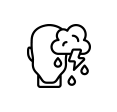Is Depression a Disability? 3 Types that Qualify SSDI
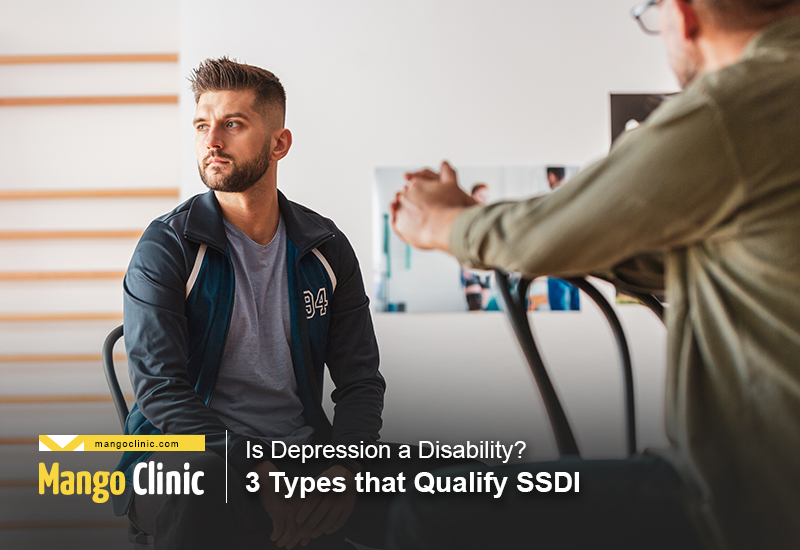
Depression can interfere with your life making you dysfunctional to some extent. That is why it can be regarded as a disability. In that effect, there is a lot that can be done to mitigate it as long as it is correctly diagnosed under the right criteria. The SSDI, a perfect certified program, is the criteria used to diagnose depression as a disability and to guarantee assistance, benefits, and rights to the individuals that qualify.
Proper treatment can save you from depression-related diseases. Click the button below to book your appointment.
According to the ADA (Americans With Disabilities Act), clinical depression is covered as a disability. However, not every depressed individual qualifies for the benefits. Read through this informative piece to find out if and how you or your loved one can be assisted to get through or live with depression.
Table of Contents
1. When Is Depression a Disability? You Can Be a Victim Too!
Depression will get your mood low or blue for hours or days, or even longer. Being depressed daily will have you not enjoying the activities you would normally have fun doing. The fact that depression cripples your average productivity is a disability.
There is that feeling of hopelessness and reduces self-worth. You may sleep for longer hours and lack the strength to get out of bed and face the world. In other instances, you experience insomnia and constant headaches.
One symptom of depression will elicit after another, from low energy to lack of enthusiasm. All these symptoms may be chronic or can be experienced in cyclic episodes of highs and lows. Depression will lower your performance generally. Causes can be attributed to environmental and genetic factors. Having a history of alcohol and or drug use can be the cause of depression.
The depression may start from certain painful and heartbreaking situations that will lead to episodes of sadness. The attacks may be short at first, but as your condition worsens, you will deteriorate mentally and physically. Clinical depression will cripple your normal daily productivity due to the inability to cope with stress. Depression can render you functionless with the inability to work, perform a routine task, or even make rational decisions.
Currently, depression is on the top list of mental disorders, ruining peoples’ lives in the United States. The Covid-19 pandemic has worsened the cases of depression as lockdowns, curfews, and layoffs play a big role in damaging mental health.
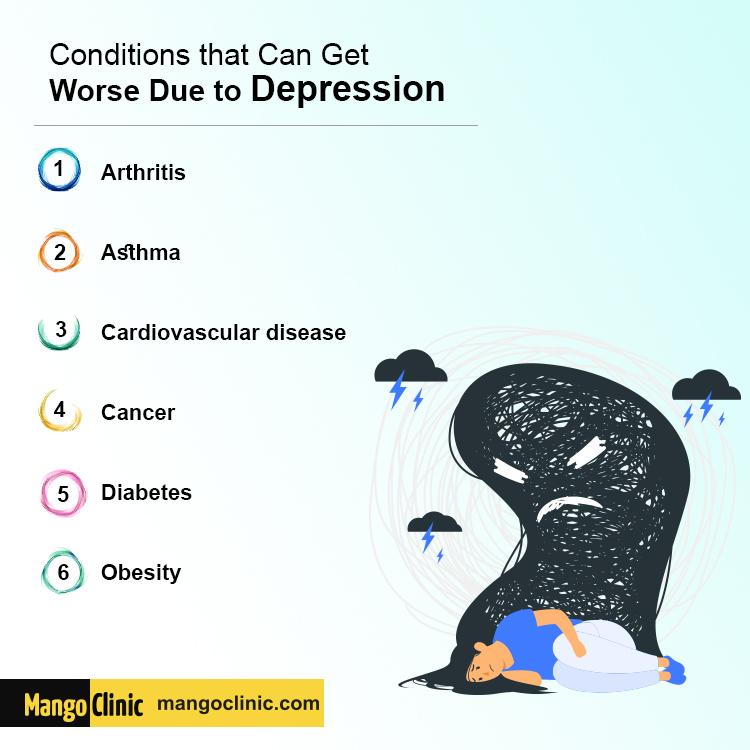
Some of the symptoms you can present include:
- Low concentration
- Anxiety
- Overeating
- Lack of appetite
- Loss of interest in the surroundings and most activities
- Anhedonia
- Lack of motivation
- Low self-esteem
- Low libido
- Insomnia
- Agitation
- Oversleeping
- Hopelessness
- Persistent sadness
- Feeling of guilt
- Excessive fatigue
- Inability to complete tasks
- Suicidal thoughts
You should not give up hope as there are various forms of treatment to cure the illness. The treatment works, and you can resume and be your normal self. However, if depression resists treatment, it is a disability.
Contact us today for depression treatment or click the banner below to book your appointment.

2. Depression – Disability Benefit Programs
Finding yourself in this situation may seem hopeless, but it isn’t. There is the hope of solving the problem. The SSDI (Social Society Disability Insurance) is a certified program created to support individuals going through the tough phase. The program doesn’t cater to every person battling depression, not unless you fit the criterion used.
When you qualify to receive some benefits if your depression leads to disability, you and your family members receive benefits once you enroll in the program. Supplemental Security Income (SSI) covers adults and children with less financial capabilities and resources.
Even though the two programs work separately, their main aim is to assist individuals with disabilities, and depression disability is included. If you plan to apply to the program, do your research and know what is required during application to smoothen the process.
The medical requirements for both programs are the same. For the non-medical criterion, you are entitled to monthly benefits if your medical condition lasts a year or longer and if the illness may lead to death.
The requirements for enrollment in disability programs include:
- Inability to work due to depression.
- Low-income.
- Assets are lower than $2000 worth.
- Spouses also have insufficient support, and combining you and your spouse’s assets should be lower than $3000 in total.
- Your depression should be considered severe to be a disability.
- You cannot work based on your current condition, age, disability, and work history.
Get depression treatment from expert physicians. Click the button below to book your appointment.
Documents you will be required to provide for the application are:
- A birth certificate or driver’s license indicates your age.
- Names and dosages of the medication you have been using.
- Report on all your past jobs.
- Social Security number.
- The names, addresses, and contact of your healthcare providers.
- Proof you are a U.S citizen.
- Your federal tax return or recent W-2.
- If you served in the U.S military before 1968, have your discharge letter.
- A medical report detailing your disability and ailment.
It would be wise to have the above documents ready and photocopied for the application into the disabled program. Other documents may be required to do thorough research to lessen the application load.
3. How Can You Get SSDI for Depression? Criteria to Qualify
The SSDI application will benefit you if you have been struggling with depression for a year or longer, and you are unable to work as before. Mental health disorders are added to the list of medical conditions that qualify you for the benefits. These mental conditions include; depression, schizophrenia, autism spectrum disorder, and bipolar disorder.
To qualify for the SSDI, you must experience a minimum of at least five symptoms of depression listed above. You should also have at least one of the following:
- You cannot comprehend information dished to you, interact with others, have the right concentration, and take care of yourself. To qualify, you must be experiencing a minimum of two of the listed symptoms.
- Your depression is considered a disability if your medical records indicate that your symptoms have been persistent. You have been receiving treatment for depression for at least two years.
- You should also be having a hard time adapting to your new lifestyle of living with depression as a disability and adapting to the new set routine.
To have more credit, you should have worked before and paid for your Social Security. The credits are based on your annual net income. If you are not confident whether you qualify for the SSDI, you can contact the administration to confirm your eligibility.
According to the SSDI, you can qualify for exclusive monthly benefits or instead get a medical-vocational allowance.
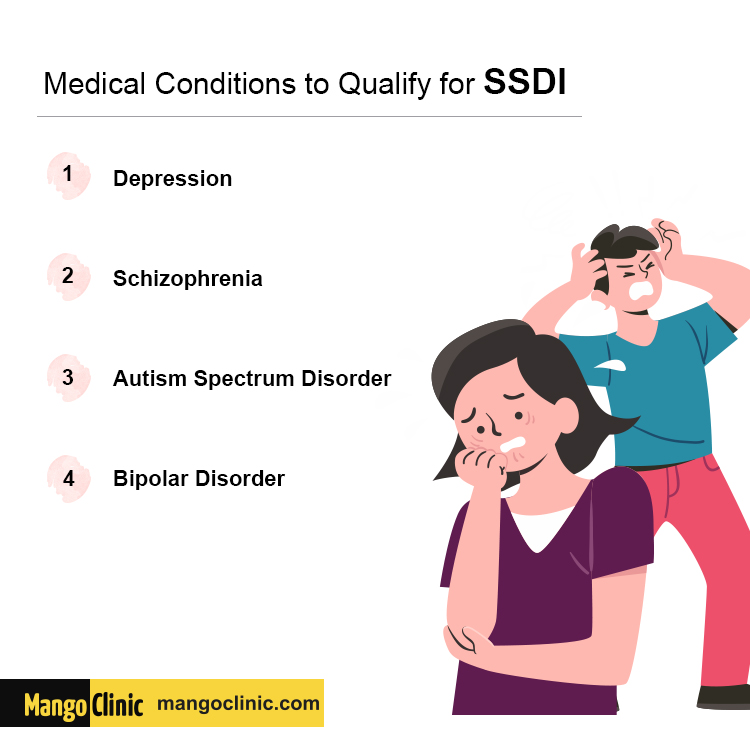
For you to receive medical funding, the following are needed:
- You must have well-documented medical records of your illness, laboratory investigations, and treatment administered for at least two years.
- Medical reports are required in indicating that your depression is affecting your work performance. The persistence of the disease is despite treatment and hours of counseling.
- Your medical report must indicate that there are periods during which your symptoms worsen. The periods should be extended and recurring. OR
- The records should show depression worsening your symptoms with minimal impact on the mental and environmental demands. OR
- The depressive state you are at is severe enough for you not to live outside a supported living arrangement.
The application forms will require you to answer some YES or NO questions on; whether you are currently receiving any disability benefits if you have been out of work for a year or longer, if you have an attorney, and still receive treatment from a doctor. Personal information like name, driver’s license, age, sex, social security number, and contact for the application process.
4. What Are the Three Types of Depression Which Are Eligible for SSDI?
Psychiatrists will classify the severity of the depression as mild, moderate, or severe forms. The Diagnostic and Statistical Manual of Mental Disorder (DSM) is among the bodies determining the qualification for the benefits. Either way, the states of depression that are eligible for the SSDI are only three and are dependent on your productivity at work, the capability to attend school, and how you interact with others. The disorders are;
1. Major Depressive Disorder (MDD) – This form of depression occurs when you are experiencing persistent sadness for prolonged periods occasionally. Normal episodes of sadness are normally a part of being human, but the mood changes are severe when you suffer from a major depressive disorder.
This condition’s trigger may occur following life events like the death of a loved one, divorce, or diagnosis of a chronic illness. Clinical depression will have led to a significant deterioration of your moods and behavior, affecting your social life, work, or school. Studies done in 2017 show that about 7% of adults in the U.S have experienced an MDD episode. Some individuals never seek out professional help, but most do. They learn how to overcome, function, and heal from the disorder.
Talk to an expert physician at Mango Clinic for mental health issues or click the banner below to book your appointment.

The diagnostic criteria:
- You must note a major change from your normal function.
- Episodes and symptoms should occur for 2 or more weeks.
- You must be experiencing five or more symptoms of; irritability, disinterest, sudden weight gain or loss with a change of appetite, restlessness, lethargy, suicidal thoughts and self-harm, worthlessness, and insomnia.
The trigger factors are; alcohol consumption and drug abuse, medical conditions like cancer or hypothyroidism, particular medication, and childhood abuse history.
Treatment can be by the use of antidepressants and psychotherapy. To improve symptoms:
- Healthy eating of foods with omega fatty acids, rich in vitamin B and magnesium.
- Avoid alcohol intake and use of drugs.
- Exercise and keep your body fit
- Sleep well for about 7-9 hours
2. Dysthymia – The main characteristic symptoms of this disorder are depression and anhedonia, an inability to find pleasure in normally pleasurable things. This condition can last for two years or more. Dysthymia may seem like a lesser evil, but the disease is equally as chronic as the rest.
Symptoms presenting are; poor concentration, overeating, insomnia, oversleeping, difficulty in engaging in everyday activity, and suicide among to name just a few.
The criteria used to determine the severity is similar to that of MDD. Treatment involves medication and psychotherapy.
The program evaluates its criteria on dysthymia and SSDI to qualify for the monthly benefits, as explained earlier. The same rules apply to major depressive disorder applicants too.
3. Manic Depression – This disorder is also known as bipolar disorder. Manic episodes involve hallucinations, psychosis, paranoia, and delusions. This disorder is associated with mood swings with extremes on the highs and lows. The cycle includes symptoms occurring mildly and progressing to severe at least four or more times a year.
The diagnosis can be made on individuals aging between 15-24. The etiology is unknown, but it comprises a disruption of normal brain function and can be genetic, meaning it can be inherited from your familial line.
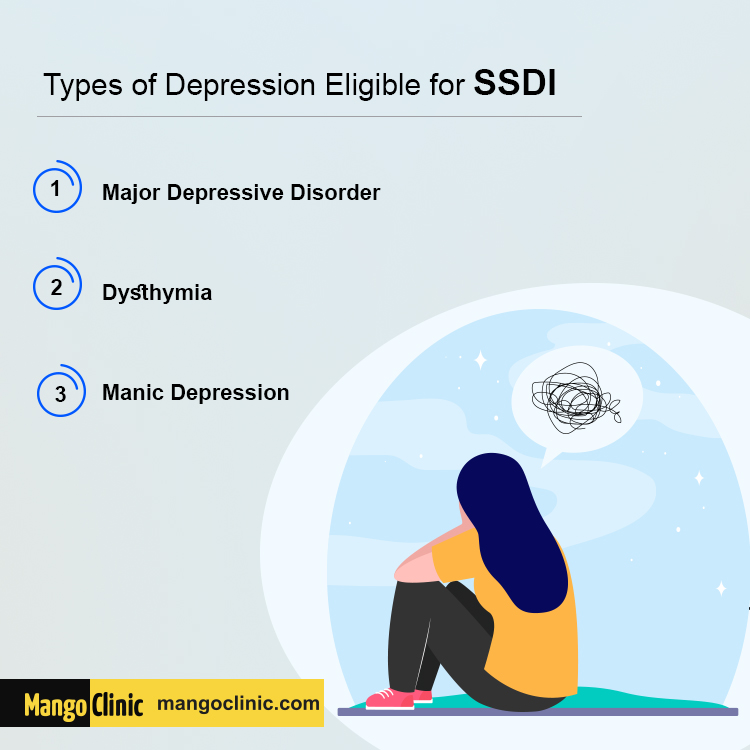
Presenting Symptoms Include:
- Decreased appetite, overeating with weight gain or loss
- Poor judgment
- Hopelessness
- Insomnia, waking up early, or oversleeping
- Disinterest in the surrounding environment
- Low libido
- Restlessness
- Suicidal attempts
Signs of Mania in Bipolar 1 Disorder Are:
- Disconnected thoughts or judgment
- Extremely high energy
- Increased sex drive
- Euphoria
Mania is the main symptom of bipolar 1, while episodes of hypomania characterize bipolar 2. The difference between the two is the severity of the condition.
Signs of Hypomania in Bipolar 2 Disorder:
- Decreased sleep
- Overconfidence
- Reckless and risky behavior
- Increased normal activity
Diagnosis is based on presenting signs and symptoms. Treatment is by use of mood stabilizers, anticonvulsants, and antidepressants.
Cyclothymia is the mild form of bipolar disorder, meaning the mood swings are not as chronic. The difference between the two is dependent on the severity and duration of the mood swing. To be eligible for the SSDI, you have to meet the criteria used by the program. Some of the considerations are not functioning generally despite proper treatment or by listing any of the chronic forms of depression-like bipolar disorder.
Get rid of chronic forms of depression. Click the button below to book your appointment.
5. Is There Another Way to Get Social Security Benefits if You Do Not Meet the Listing for Depression?
Yes, there is!
You can try qualifying for disability based on reduced functional capacity, applying the criteria of mental Reduced Functional Capacity(RFC).
What is Mental RFC?
Describes the work you’re able to perform even with the limitations your mental illness places on you.
After your application, RFC evaluates your mental capabilities and the activities required to perform. The following criteria are used.
- Intellectual functioning
- Social functioning
You will now be categorized under the labels: “markedly limited” and “moderately limited.” Insufficient evidence is also an option.
The SSA’s satisfaction is essential; otherwise, it will be difficult getting anything from your disability. SAA works on the following areas;
-
Understanding and Memory
Your level of understanding and making correct decisions is assessed by SSDI, who are interested in the severity of your condition based on your capability of following instructions, remembering, and executing simple tasks. If you can follow through with simple instructions, you are marked limited and can perform unskilled labor. On the other hand, you can be marked as a misfit if your condition is affecting your memory and ability to understand simple instructions.
-
Social Interactions
How well you can focus on interests and activities is also important in determining your mental RFC. The SSA calls this “concentration, persistence, and pace” related to your ability to pay attention and concentrate long enough to complete everyday work or tasks.
If you are found “markedly limited” in any of the following areas related to concentration and persistence, you are unable to perform unskilled work: maintaining concentration and attention; keeping a routine without constant supervision; carrying out simple instructions; preventing being distracted by other people; making simple decisions; staying on schedule, and showing up to work on time.

-
Adaptation
Your capability to adapt to the work environment is evaluated based on your response to hiccups at work. If your depression is not as severe and you can at least tackle some of the pressures, then you are marked limited. In that case, you are unable to perform unskilled tasks.
SSA considers both medical and non-medical evidence in determining the benefits. All you need to do is compile all your medical records, tests, reports, psychological evaluations, and healthcare experts’ statements that prove your mental disorders.
6. How to Apply for SSDI? Application Stages
The criteria for application in cases of depression disability are:
First Stage:
You have to decide on how you want to go about the application process. You can apply by yourself, or you can seek help from a disability attorney for a fee. If you have enough knowledge of the requirements and have all the required forms for the application, you can do the application process yourself and save some money. The good thing is that most disability attorneys work on contingency, meaning you are charged if you win your case. The attorney can also guide you if your application is denied.
Second Stage:
Determine whether you are eligible for application and have the required documents in order. Inform your mental health provider as information will be acquired from them by the SSDI. The medical providers will need you to sign forms permitting them to share your medical information with the SSA. The report given will be used to determine when you qualify for the disability benefits. Have all the necessary documents for enrollment ready.
Last Stage:
Complete the application. The process can be done online, in person at the Social Security office, or via phone. An online application is convenient as you can start the process immediately, you will fill the forms at your own pace, and no appointment is needed. Applying in person will demand that you call the administration to your local office with the toll-free number 1-800-772-1213. Call and make an appointment. You must be 18 years or above for an online application, currently not receiving any monthly benefits, and not denied benefits within 60 days.
Want help with depression? Click the button below to book your appointment.
When you go through the whole application process, wait for a confirmatory notification on your phone or via email. Your application is reviewed, and the insurance will call if any information is unclear. You will wait for about 3-5 months to receive the SSDI verdict on the matter.
During the wait, be ready mentally that your application will likely be denied, but all hope is not lost as you can apply for a reconsideration.
Reconsideration Request
In case of rejection, which happens to almost everyone on the initial application, you still have 60 days to reapply for a reconsideration. The team in charge will re-evaluate your claim and allow you to receive disability benefits due to the depression.
Not to burst your bubble, but the SSDI program team can also deny the second application. When this happens, there is no need to panic as you can still have one last try. After your second re-application is declined, you have 60 days to request a third hearing. At this final stage, your chances of benefits approval are high.
The third and final hearing is to an Administrative Law judge, and you receive a 30 days notice of the date of your hearing. This last hearing is conducted at your local Office of Disability Adjudication and Review (ODAR). It is advisable to get your disability attorney to represent your claims as they are more experienced with this kind of scenario. Representing yourself is a bad idea, so don’t do it!
It takes the team involved a few months to make the decision. If your claim is approved, you receive a reward notice. It may go either way, and your re-application may get rejected. When that happens at this point, your move will be to present your case to the Appeals Council. Seek help from a disability attorney; don’t torture yourself with matters you don’t fully understand. The attorney will handle the presentation of your case for an appeal.
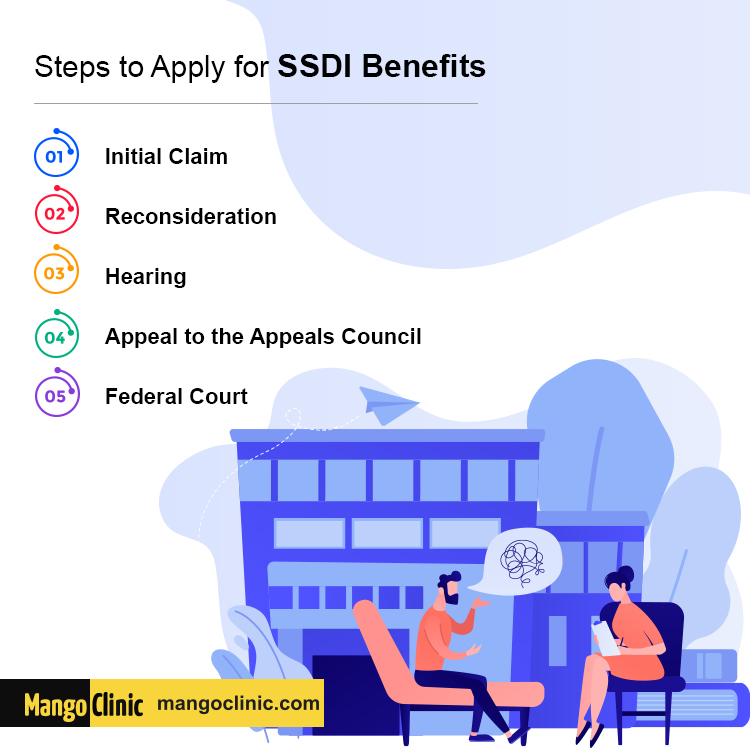
If your application is accepted, you can benefit as long as the depression still prevents you from work. With continued treatment, and when your condition improves, and you can go back to work, you are off the benefits. Your disability is reviewed occasionally to prove you are still eligible to receive the benefits.
With recovery and return to work, you should inform the SSA so that your services can stop because you can now make some money on your own. In instances where you are still receiving SSDI and retire, there will be a transfer of the benefits to your retirement benefits without a change in the amount received.
7. What Can Cause SSDI Benefits to Cancel?
While receiving SSDI benefits, your treatment continues simultaneously.
Once recovery is met, people opt for more stable jobs.
Reasons for the cancellation are:
- Medical Improvement
- Returning to Work
- Reaching Retirement Age
- Being Incarcerated or Institutionalized
- Going about the Income or Asset Limits
- Turning 18 if one was on the benefits of the parents
- Changes in life situations
You can also secure your SSID benefits along with your work, but to do that, you are required to follow certain rules:
Rule 1# Returning to Work along with SSDI Benefits:
If you return to work while receiving the SSID benefits, SSA will consider your case as engaging in “substantial gainful activities,” but there is only one exception given; the ‘trial work period.’ This trial period allows a person to return to work without losing the benefits of SSDI. According to this exception, you can work up to 9 months despite how much you can earn.
Rule 2# Reaching the Age of Retirement while on SSDI:
You cannot stop yourself from aging. The retirement age for the benefit is 66 years. Upon reaching, the service is terminated as this can be prevented by switching to the social security retirement benefits program, which has the same payments gained.
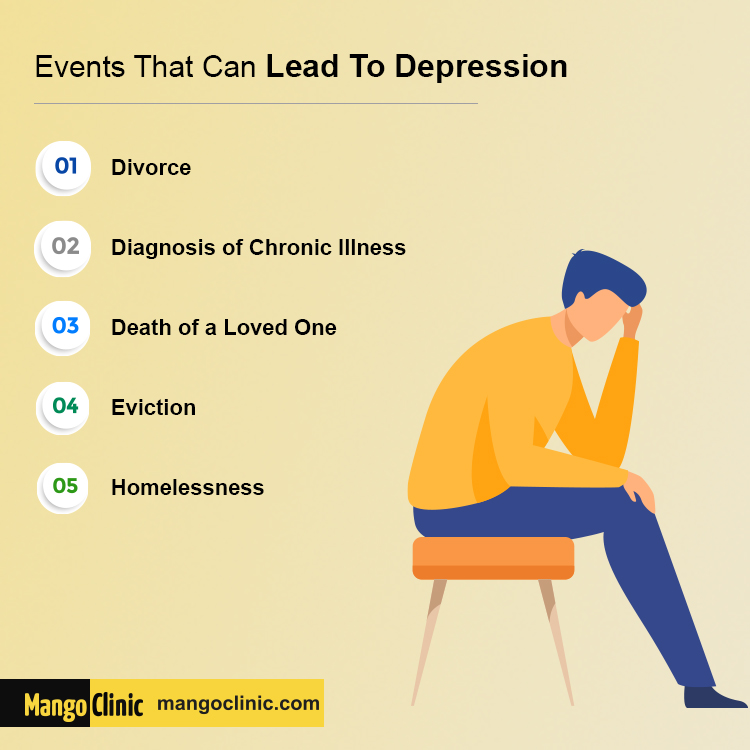
Rule 3# Being Institutionalized while on SSDI:
If you are convicted or found guilty of a crime, your benefits are nullified throughout your sentence. After completing your sentence, you are required to undergo some rehabilitation session therapies. Failure to do so, the services will be suspended for good.
Rule 4# Improvement in Mental Depression-Disability Condition:
Upon improving mental health, the SSDI and SSI benefits will automatically be stopped, but that does not necessarily mean it is done. The social security department will periodically view your condition, usually every 3 to 7 years, to determine your disability. Around 85 % of all beneficiaries continue to receive the benefits even after recovery. The appointment of a disability attorney can help ease the process of securing SSID benefits.
You can qualify for health insurance by Medicaid, a federal government program that works with low-income earners. The health insurance is after at least two years of having the SSDI, but you can apply for the health insurance after a month of receiving SSDI payments. Depression resistance to treatment will most definitely lead to a disability.
The disability qualifies you to apply for financial support to supplement your lost income source and possibly health insurance. The payments may range from about $600-$1300 monthly, depending on how much you had been paying to the program.
Depression is currently a common illness worldwide, with over 264 million people affected. People of all ages can suffer from depression, depending on their environmental and genetic factors. Women tend to be more affected compared to men. Chronic levels of depression can lead to suicidal attempts.
Following the stress people get from unavoidable life struggles, normal sad moods may be prolonged and lead to depression. Most depression is situational, and your sadness will float away when the situation gets better. The situation may be events like divorce, diagnosis of chronic illness, death of a loved one, eviction, and homelessness, to name but a few. This type of sorrow is standard as long as it doesn’t get to the chronic state. In a more severe form, it becomes clinical depression.
Get yourself treated for clinical depression. Click the button below to book your appointment.
The Takeaway
To qualify for the SSDI benefits for disability due to depression is not an easy task. You must at least have five of the major symptoms, as mentioned above, to qualify for the program. Application for disability benefits is not an easy job either. A lot of your personal information is required to evaluate if you are eligible for the services.
The sad part is that there is a chance of SSDI denying your application, which can happen even after the second and third applications. You can do the process yourself on your laptop or via phone, but if your application is rejected, make an appeal for reconsideration and get help from a disability attorney.
Contact us at Mango Clinic to get SSDI benefits for disability due to depression or click the banner below to book your appointment.


